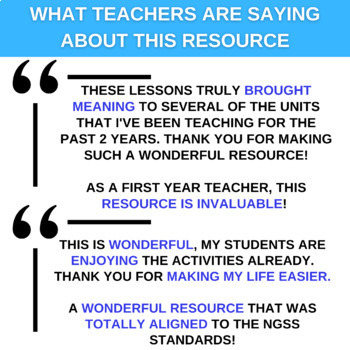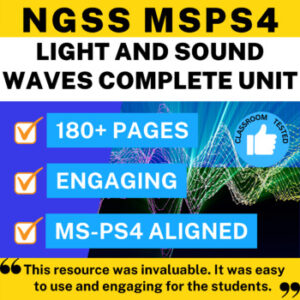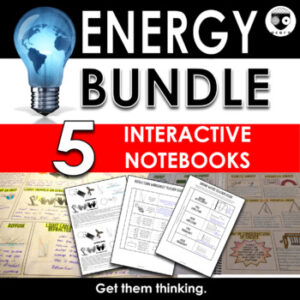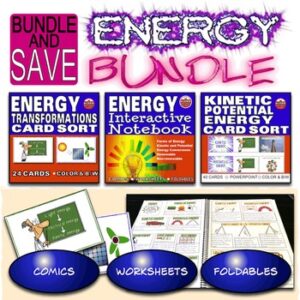Description
“This is wonderful, my students are enjoying the activities already. Thank you for making my life easier!” Anita C. This lesson plan bundle covering the entire NGSS Middle School Physical Science curriculum is now complete. It is packed with resources specially designed to align with the NGSS curriculum and standards. Powerpoints, notes, INB pages, labs and bellringers all compliment each other to save you time and make life a little easier.
A google classroom version is also included for each resource so that you can teach remotely or face-to-face. Either way you’re all set.
“Lots of great resources to use in 8th grade. I liked how it is NGSS aligned so I know the standards it contains. This is a great resource to have for all of the physical science standards. This is over half my curriculum (energy, waves and chemistry) in one place. Thanks for the hard work in creating it :)” Karen M
“This resource really saved my life last year. I was a first year teacher and my first experience teaching physical science. This helped SO much! Thank you!” Sarah L.
“This is wonderful, my students are enjoying the activities already. Thank you for making my life easier!” Anita C.
“Thank you for a much needed guide on how to approach the standards! Can’t wait to use this in the classroom!”
MATTER AND ITS INTERACTIONS
ATOMS AND MOLECULES MIDDLE SCHOOL NGSS MS-PS1-1
This comprehensive Middle School NGSS packet on Atoms and Molecules is designed to align with the NGSS Middle School MS-PS1-1 standard. A visually interactive 60 slide powerpoint covers the main concepts in the standard “develop models to describe the atomic composition of simple molecules and extended structures”. The structure of atoms and molecules is covered as well as extended repeating structures such as NaCl and graphene. Over 40 pages of student activities, questions and notes complete and compliment this engaging resource.
Topics covered:
- Atomic Timeline
- Structure of the Atom
- Molecules (same, different atoms)
- Elements and Compounds
- Repeating Subunits – Carbon, NaCl
- Solids, Liquids, Gases
- Change on State – Increase in Energy
- Change of State – Decrease in Energy
- 2 Science Reading Articles and the Atomic Timeline and Mendeleev (these make excellent sub plans)
- Atoms and Molecules Activities including Make a Molecule/Draw a Molecule
- Warm-ups/Bell-ringers/Homework
- Changes of State Comics which are perfect for an INB.
PHYSICAL AND CHEMICAL CHANGES MS-PS1-2
This comprehensive Middle School NGSS packet on Physical and Chemical Reactions is designed to align with the NGSS Middle School MS-PS1-2 and MS-PS1-5 standards. A visually interactive 50 slide powerpoint covers the main concepts in the standards “analyze and interpret data on the properties of substances before and after the substances interact to determine if a chemical reaction has occurred” and “develop and use a model to describe how the total number of atoms does not change in a chemical reaction and thus mass is conserved”. The physical and chemical properties of substances is covered as well as looking at everyday chemical interactions. Over 20 pages of student activities, questions and notes complete and compliment this engaging resource.
This is typically a topic that students find hard to grasp. I’ve designed this in simple incremental steps that builds upon previous knowledge that is sure to make this topic more engaging.
Topics covered:
- PS1-A – Each pure substance has characteristic physical and chemical properties (for any bulk quantity under given conditions) that can be used to identify it.
- PS1-B – Substances react chemically in characteristic ways. In a chemical process, the atoms that make up the original substances are regrouped into different molecules, and these new substances have different properties from those of the reactants. (MS-PS1-2),(MS-PS1-3),(MS-PS1-5)
- The total number of each type of atom is conserved, and thus the mass does not change. (MS-PS1-5)
- Warm-ups/Bell-ringers/Homework
- Acid/Base Neutralization Comic which are perfect for an INB.
NATURAL AND SYNTHETIC RESOURCES
This comprehensive Middle School NGSS activity pack on Synthetic and Natural resources is designed to align with the NGSS Middle School MS-PS1-3 standards.
⭐ MS-PS1-3. Gather and make sense of information to describe that synthetic materials come from natural resources and impact society.
This pack contains 6 activities that can be used individually as is or combined to make science stations (signage is included).
The activities are:
- Watch It – In this activity the students are asked to watch some Youtube videos on vitamins and diamonds (both natural and synthetic) and answer the accompanying questions.
- Analyze It! – Students will analyse a graph showing synthetic trends and answer the questions on the student handout.
- Sort It! – The students must sort the items into either natural or synthetic. Then they must pick 2 from each list and give reasons as to why they are on that list.
- Illustrate It! -The students are supplied with text and must read it and then create either an infographic, comic, poster or diagram showing how the synthetic material is produced from a natural resource.
- Read It! – At this station the students will read a scientifically referenced article on the societal impact of plastic. Short questions check their understanding of the article.
- Explain It! – This activity is designed to elicit their understanding of the unit and should take place at the end of the unit/stations.
This comprehensive Middle School NGSS packet on Heat and Thermal Energy is designed to align with the NGSS Middle School MS-PS1-4 standard. A visually interactive, fully editable 40 slide powerpoint covers the main concepts in the standard “develop a model that predicts and describes changes in particle motion, temperature and state of a pure substance when thermal energy is added or removed”. Over 50 pages of student activities, questions and notes complete and compliment this engaging resource.
Topics covered:
- What is Heat?
- What is Thermal Energy?
- Solids, Liquids, Gases
- Change of State – Increase in Energy
- Change of State – Decrease in Energy
- Graphing changes of state
- Thermal Energy/Temperature/Heat
- Transfer of heat: conduction, convection, radiation
- Motion of gas particles/pressure
- The effect of increasing/decreasing pressure on boiling point
- Warm-ups/Bell-ringers/Homework for 2 weeks
Loads of pages which are perfect for INBs including comics on heat v temperature, heat transfer and the effect of pressure. These are all differentiated and can also be used for homework or revision.
This comprehensive NGSS Middle School NGSS activity pack on exothermic thermal energy is designed to align with the NGSS Middle School MS-PS1-6 standards.
⭐ MS-PS1-6. Undertake a design project to construct, test, and modify a device that either releases or absorbs thermal energy by chemical processes.
This pack comprehensively covers the NGSS requirements for this lab. A visual handout on endo/exothermic reactions prepares the students for the actual lab. In this lab the students have to create an exothermic reaction. This lab uses common household materials. Following on from the experiment the students will complete a graphing activity which is based on the data collected from the experiments.
A Claim Evidence Reasoning (CER) activity compliments this pack. Answer keys for all activities are included.
MOTION AND STABILITY: FORCES AND INTERACTIONS
This comprehensive Middle School NGSS packet on Force and Motion is designed to align with the NGSS Middle School MS-PS2-1-5 standards. A visually interactive 60+ slide powerpoint covers the main concepts in the standards. Over 75 pages of student activities, INB pages, warmup/bellringers, questions and notes complete and compliment this engaging resource.
Topics covered:
- MS-PS2-1 Apply Newton’s Third Law to design a solution to a problem involving the motion of two colliding objects.
- MS-PS2-2. Plan an investigation to provide evidence that the change in an object’s motion depends on the sum of the forces on the object and the mass of the object.
- MS-PS2-3 Ask questions about data to determine the factors that affect the strength of electric and magnetic forces.
- MS-PS2-4 Construct and present arguments using evidence to support the claim that gravitational interactions are attractive and depend on the masses of interacting objects.
- MS-PS2-5. Conduct an investigation and evaluate the experimental design to provide evidence that fields exist between objects exerting forces on each other even though the objects are not in contact.
- Forces – balanced, unbalanced, net forces
- Newton’s 3 Laws
- Momentum
- Magnetic and Electrical Forces
- Gravity
- 3 Science Reading Articles on Newton, Magnetism and Electricity (these make excellent sub plans)
- Forces Comic
- Magnetism Comic
- Electromagnetism Comic
→(These are differentiated and are perfect for an INB.)
WAVES AND THEIR APPLICATIONS IN TECHNOLOGIES FOR INFORMATION TRANSFER
Save time with this complete unit that covers the Middle School NGSS MSPS4 standards. Specially designed to align with the NGSS standards this complete bundle on waves is packed with engaging and interactive activities.
This pack covers the following standards for MSPS4:
- MS-PS4-1. Use mathematical representations to describe a simple model for waves that includes how the amplitude of a wave is related to the energy in a wave.
- MS-PS4-2. Develop and use a model to describe that waves are reflected, absorbed, or transmitted through various materials.
- MS-PS4-3. Integrate qualitative scientific and technical information to support the claim that digitized signals are a more reliable way to encode and transmit information than analog signals.
65+ slide powerpoint covering:
- Introduction to waves
- Types of waves
- Transverse and longitudinal waves
- Compression and rarefraction, seismic waves
- Anatomy of a wave
- Energy of a wave
- Amplitude, frequency
- Energy is proportional to amplitude
- Energy and frequency
- Sound waves
- Sound waves need a medium
- Sound waves – -reflection, echoes, sonar
- Sound waves – absorption
- Sound waves – interference, constructive, destructive
- Sound waves – pitch and frequency
- Sound waves – amplitude and loudness
- Sound waves – doppler effect
- Electromagnetic Waves
- Light waves
- Light travels in straight lines
- Light – reflection, refraction
- Light – converging, diverging lenses
- Light – transmission, transparent, translucent
- Light – color, frequency, wavelength
- Light – how we see color
- Light – amplitude
LIGHT and Sound INB Pages
- Properties of Light Comic – With these comics students read a supplied text and then make their own comic using the images supplied. A differentiated version is included. This will really let their creativity loose!
- Let’s Reflect Comic – concave and convex mirrors, periscopes
- Let’s Refract Comic – this focuses (!) on concave and convex lenses and their uses
- Worksheets and Foldables
SOUND
- Good Vibrations! – With these comics students read a supplied text and then make their own comic using the images supplied. A differentiated version is included. This will really let their creativity loose!
- Sound Waves Comic – amplitude, frequency, ultrasound
- Reflected Sound Comic – echoes, echo location, sonar
- Decibel range
- Worksheets and Foldables
Bellringers/Warmups/Homework
This comprehensive Middle School Science bellringers/warmups pack on MS-PS4 Waves is designed to align with the NGSS Middle School MS-PS4 standards. There are 18 days worth of bellringers in this pack with answer guidelines. These Waves warm-ups / bell ringers are a great way to start your class and reinforce the days activities. The questions have been carefully designed to get them thinking!
DIGITAL AND ANALOG SIGNALS LABS/SCIENCE CENTRE/SCIENCE STATIONS
This pack contains 6 activities that can be used individually as is or combined to make science stations (signage is included).
The activities are:
- Watch It – in this activity the students are asked to watch Youtube videos on analog and digital and answer questions on their understanding of the terminology. This is ideal as preparatory homework for the next activity Read It! which compliments this activity.
- Read It! – This activity should take one class. Students should be familiar with the concept of waves, amplitude and frequency. Read It! combines science and literacy. Just print the 2 page handout and distribute to the students who can read and work quietly on this activity for the class. There are 8 questions on the handout and the students should write the answers to these in their science journals. You could give this as homework or use as a sub-plan as well.
- Sort It! – The students must sort the items into either analog or digital. Then they must pick 2 from each list and give reasons as to why they are on that list.
- Digitize It! -The purpose of this activity is to give the student an appreciation for the different types of digitized educational media available online.
- Tech It! – At this station the students will use both analog and digital techniques to find the temperature and pH of some common items. They will record their results in a table and compare both techniques.
- Sample It! – This is a lovely activity that shows the students simply and visually how analog sound is sampled and converted into a digital signal.
Labs included are:
- Lab 1 – Make A Wave – Students make a model of a wave using everyday household items and experiment and explore the properties of the wave
- Lab 2 – Light Travels in Straight Lines – includes a background worksheet, lab and CER questions
- Lab 3 – Light and Sound Reflection Lab – includes a background worksheet, lab and CER questions
- Lab 4 – Light Refraction Lab – the background work for this is for students to read an article about the archer fish before completing the lab
- Lab 5 – Interactive Wave Simulator Lab – this is a fantastic online resource that compliments (or you could use this to replace) the first lab on making a wave. Students will go to the link on the handout and experiment with changing the frequency and amplitude of a wave and answer questions on this. This could also be given as a homework assignment.
There are links to online video resources that will help reinforce the concepts taught.
MS-PS3 ENERGY
Middle School NGSS MS-PS3-1 KINETIC ENERGY GRAPHING ACTIVITIES
This comprehensive Middle School NGSS activity pack on kinetic energy graphing activities is designed to align with the NGSS Middle School MS-PS3-1 standards.
- MS-PS3-1. Construct and interpret graphical displays of data to describe the relationships of kinetic energy to the mass of an object and to the speed of an object.
This pack contains background reading material which explains kinetic energy and how mass and speed influence the kinetic energy of an object in an easily relatable way. Following on from the background reading the students will complete 2 graphing activities which are based on the background material. Each of the three activities has questions to elicit the deeper understanding of this concept.
- A Claim Evidence Reasoning (CER) activity compliments this pack. Answer keys for all activities are included.
Middle School NGSS MS-PS3-2 POTENTIAL ENERGY
This comprehensive NGSS Middle School NGSS activity pack on potential energy transfer is designed to align with the NGSS Middle School MS-PS3-2 standards.
- MS-PS3-2. Develop a model to describe that when the arrangement of objects interacting at a distance changes, different amounts of potential energy are stored in the system.
A 20 slide powerpoint elegantly illustrates the standards in a student friendly way. The powerpoint is packed with visuals and animations. This is a fun way to engage students and they’ll easily be able to make the connection between potential energy and distance/position. A worksheet compliments this.
- A Claim Evidence Reasoning (CER) activity compliments this pack. Answer keys for all activities are included.
Teacher answer guides are included.
THERMAL ENERGY INSULATION LAB MS-PS3-3
This comprehensive NGSS Middle School NGSS activity pack on thermal energy transfer is designed to align with the NGSS Middle School MS-PS3-3 standards.
- MS-PS3-3. Apply scientific principles to design, construct, and test a device that either minimizes or maximizes thermal energy transfer.
This pack comprehensively covers the NGSS requirements for this lab. A non-fiction background reading article with questions (and answers) prepares the students for the lab. In this lab the students have to create a thermal heat shield (THS) to protect their valuable cargo from heat loss. Following on from the experiment the students will complete a graphing activity which is based on the data collected from the experiments.
- A Claim Evidence Reasoning (CER) activity compliments this pack. Answer keys for all activities are included.
THERMAL ENERGY TRANSFER LAB MS-PS3-4
This comprehensive Middle School NGSS activity pack on thermal energy transfer is designed to align with the NGSS Middle School MS-PS3-4 standards.
- MS-PS3-4 Plan an investigation to determine the relationships among the energy transferred, the type of matter, the mass, and the change in the average kinetic energy of the particles as measured by the temperature of the sample.
This pack uses common household items and comprehensively covers the NGSS requirements for this lab. Following on from the experiments the students will complete a graphing activity which is based on the data collected from the experiments. The activity has questions to elicit the deeper understanding of this concept.
- A Claim Evidence Reasoning (CER) activity compliments this pack. Answer keys for all activities are included.
KINETIC ENERGY TRANSFORMATIONS MS-PS3-5
This comprehensive NGSS Middle School NGSS activity pack on kinetic energy transfer is designed to align with the NGSS Middle School MS-PS3-5 standards.
- MS-PS3-5. Construct, use, and present arguments to support the claim that when the kinetic energy of an object changes, energy is transferred to or from the object.
- A preparatory background activity uses an online skate park simulation. This is a fun way to engage students and they’ll easily be able to make the connection between kinetic and potential energy. Another activity from NASA compliments this. These are perfect for a homework/preparatory assignment.
- Following on from this is a differentiated comic on kinetic and potential energy. This includes a no-prep version as well.
- Energy Explainers – there are two activities in which students must explain various energy transformation.
- A Claim Evidence Reasoning (CER) activity compliments this pack. Answer keys for all activities are included.
Teacher answer guides are included.
www.acornscience.com
All rights reserved by author. This product may only be used by the original purchaser. Copying for more than one teacher, classroom, department, school, or school district is prohibited. This product may not be distributed or displayed digitally for public view. You may not post this product online including classroom websites, school networks or file sharing sites. Failure to comply is a copyright infringement and a violation of the Digital Millennium Copyright Act (DMCA).
NGSS and Next Generation Science Standards are a registered trademark of Achieve. Neither Achieve nor the lead states and partners that developed the Next Generation Science Standards was involved in the production of, and does not endorse, this product.










